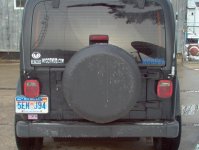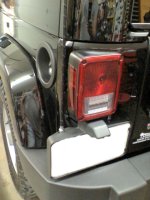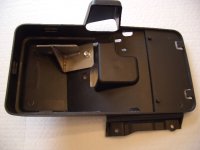Choosing a CB Antenna
There are a large number of CB antennas on the market and it can be a daunting task selecting one. When choosing a CB antenna it’s important to consider the antenna’s mounting location, brand type, length, mount size, coil location and ground plane.
Mounting Location Considerations
Mounting location is a difficult topic to advise upon due to each individual’s unique circumstances and preferences. Antennas can be mounted a number of places including on a vehicle’s roof, mirror bars, hood channel, bumper and trunk. Each method has advantages and disadvantages and it’s up to each individual to weigh these relative to their own needs and preferences. There are a few general rules to keep in mind when considering CB mounting options:
While it’s not always possible to follow all the previous CB antenna mount suggestions, following as many as possible will result in better antenna performance.
Length
Longer CB antennas work better than shorter antennas, so select the longest length that can be comfortably used. Accessories such as quick-disconnects are available that allow for fast and tool-free CB antenna removal when additional clearance is required (garage parking, drive-throughs, etc).
Mount Size
It’s important that a mount be sturdy enough to support a selected antenna. While a small roof magnet mount would be well suited for a short 2’ fiberglass CB antenna, it would be a very poor choice for a heavy center-loaded 5’ long antenna (as the momentum of the antenna while driving would likely cause the magnet mount to come loose). When selecting a CB antenna, make sure the chosen mount will be able to provide adequately support.
Antenna Brand
We recommend picking a quality CB brand as the antenna is the most important determinant of system performance. A good quality fiberglass CB antenna can be purchased for around $20, so there’s really no reasons to scrimp on such an important system component. Antennas from Firestick, Wilson and K-40 are all high-quality antennas we’re very comfortable recommending.
Antenna Types by Coil
CB antennas can generally be grouped into three categories by load position. An antenna’s load position refers to the location where the antenna wire is wound into a coil. The optimal antenna length for CB frequencies is 102†as this represents one quarter of a wavelength. However, mounting a 102†(8.5 foot) antenna to a vehicle is usually not an option.
To get around this problem, manufactures wrap coil tightly along the antenna body in order to compensate for the reduced antenna length. In other words, a longer length similar to that of the 102†whip is achieved on a shorter CB antenna by wrapping the antenna wire close together, forming a coil. While this isn’t nearly as efficient as using a regular 102†antenna, it allows for shorter and more practical CB antennas.
Antennas can be categorized based on their coil location:
Top-Loaded Antennas
Top-loaded CB antennas tend to be made of fiberglass. While the coils of base and center loaded antennas are usually contained in a plastic housing, top loaded fiberglass antennas utilize a thin wire that is wrapped along the antenna’s exterior shaft and covered with a protective layer.
As the name implies, base-loaded CB antennas have their coil located at the bottom of the antenna. Many all-in-one magnet mounted and roof antennas are base-loaded. An all-in-one antenna refers to a product that contains the antenna, mount and cable in a single unit.
These antennas have their coil located in the middle of the antenna. This description is slightly misleading as the coil is usually located near, but not at, the bottom of the CB antenna. Most center-loaded antennas utilize a thick stainless steel shaft that makes up the bottom 1/3 to 1/4 of the antenna. The coil sits above this shaft, usually in a plastic housing, and the remainder of the antenna consists of a long and thin steel whip. Many popular professional trucking CB antennas are center-loaded.
When installing a CB antenna on an RV, boat or any vehicle with no metal chassis, a no-ground plane CB antenna kit is required. A traditional CB antenna utilizes the metal chassis of a vehicle when transmitting the radio’s signal. Without a good ground plane, the antenna will provide extremely poor performance.
No-ground plane (NGP) CB antennas have the required ground counterpoise built in to the coax cable and allow for operation without an external ground. Traditional ground plane antennas tend to have a 15% to 20% stronger field strength than similar NGP antennas. Subsequently, it’s always preferable to use a traditional ground-based antenna if a good ground plane is available. NGP antennas come in kits that include a specially modified NGP coax and antenna and subsequently aren't interchangeable with standard ground-based equipment.
Summary
There are a number of factors to consider when purchasing a CB antenna. Regarding brands, a Wilson CB antenna, Firestick CB antenna and K-40 CB antenna are all high-quality antennas you can feel confident using. As long as all factors are properly considered, it’s a relatively simple process to select a CB antenna that will perform well for a given vehicle or environment.
<hr>
© 2008 Right Channel Radios.
There are a large number of CB antennas on the market and it can be a daunting task selecting one. When choosing a CB antenna it’s important to consider the antenna’s mounting location, brand type, length, mount size, coil location and ground plane.
Mounting Location Considerations
Mounting location is a difficult topic to advise upon due to each individual’s unique circumstances and preferences. Antennas can be mounted a number of places including on a vehicle’s roof, mirror bars, hood channel, bumper and trunk. Each method has advantages and disadvantages and it’s up to each individual to weigh these relative to their own needs and preferences. There are a few general rules to keep in mind when considering CB mounting options:
- Antennas should have their coil above the roof-line of the vehicle (coil location is discussed later in this article). For optimal performance, 2/3 of the antenna should be above the roof-line.
- Antennas mounted higher on the vehicle tend to perform better
- It’s critical that the antenna mount be well grounded to the vehicle chassis. If a grounding jumper is used to ground the mount, it should be as short as possible. If installing an antenna on an RV or a vehicle without a sufficient ground, please refer to the “No-Ground Plane Antennas†section of this article.
- Single antennas (vs. dual co-phased antennas) tend to perform better when mounted near the center of the vehicle.
While it’s not always possible to follow all the previous CB antenna mount suggestions, following as many as possible will result in better antenna performance.
Length
Longer CB antennas work better than shorter antennas, so select the longest length that can be comfortably used. Accessories such as quick-disconnects are available that allow for fast and tool-free CB antenna removal when additional clearance is required (garage parking, drive-throughs, etc).
Mount Size
It’s important that a mount be sturdy enough to support a selected antenna. While a small roof magnet mount would be well suited for a short 2’ fiberglass CB antenna, it would be a very poor choice for a heavy center-loaded 5’ long antenna (as the momentum of the antenna while driving would likely cause the magnet mount to come loose). When selecting a CB antenna, make sure the chosen mount will be able to provide adequately support.
Antenna Brand
We recommend picking a quality CB brand as the antenna is the most important determinant of system performance. A good quality fiberglass CB antenna can be purchased for around $20, so there’s really no reasons to scrimp on such an important system component. Antennas from Firestick, Wilson and K-40 are all high-quality antennas we’re very comfortable recommending.
Antenna Types by Coil
CB antennas can generally be grouped into three categories by load position. An antenna’s load position refers to the location where the antenna wire is wound into a coil. The optimal antenna length for CB frequencies is 102†as this represents one quarter of a wavelength. However, mounting a 102†(8.5 foot) antenna to a vehicle is usually not an option.
To get around this problem, manufactures wrap coil tightly along the antenna body in order to compensate for the reduced antenna length. In other words, a longer length similar to that of the 102†whip is achieved on a shorter CB antenna by wrapping the antenna wire close together, forming a coil. While this isn’t nearly as efficient as using a regular 102†antenna, it allows for shorter and more practical CB antennas.
Antennas can be categorized based on their coil location:
Top-Loaded Antennas
Top-loaded CB antennas tend to be made of fiberglass. While the coils of base and center loaded antennas are usually contained in a plastic housing, top loaded fiberglass antennas utilize a thin wire that is wrapped along the antenna’s exterior shaft and covered with a protective layer.
- Pros: Generally the cheapest and most effective CB antenna type. It’s possible to mount top-loaded antennas lower on the vehicle as their coil (which resides at the antenna’s top) is more likely to remain above the roof-line.
- Cons: Due to the thinner coil wire size, top-loaded CB antennas generally have lower watt capacity ratings. This generally isn’t an issue when using most CB radios as 99.9% of all antennas are able to handle the 4 watt transmission limitation of all stock CBs. The lower watt capacity of fiberglass antennas is only an issue for those using a modified CB or a more powerful HAM radio.
- Popular Applications: Cars, trucks, tractor trailers and RVs. Top-loaded fiberglass antennas are generally the most versatile and popular CB antenna type.
As the name implies, base-loaded CB antennas have their coil located at the bottom of the antenna. Many all-in-one magnet mounted and roof antennas are base-loaded. An all-in-one antenna refers to a product that contains the antenna, mount and cable in a single unit.
- Pros: Offers one of the simplest mounting and installation methods with the all-in-one models. Additionally, base-loaded models are able to utilize a thicker coil and generally have a higher watt capacity rating than top-loaded fiberglass CB antennas.
- Cons: The least efficient type of antenna relative to other load positions. An antenna’s coil needs to be above the highest vehicle surface for optimal performance and this results in fewer effective mounting options for base-loaded CB antennas. The coil load may be placed below a vehicle’s highest surface, but performance will suffer.
- Popular Applications: Car and pick-up truck roofs and trunks.
These antennas have their coil located in the middle of the antenna. This description is slightly misleading as the coil is usually located near, but not at, the bottom of the CB antenna. Most center-loaded antennas utilize a thick stainless steel shaft that makes up the bottom 1/3 to 1/4 of the antenna. The coil sits above this shaft, usually in a plastic housing, and the remainder of the antenna consists of a long and thin steel whip. Many popular professional trucking CB antennas are center-loaded.
- Pros: Center-loaded CB antennas offer a slightly higher coil load than base-loaded antennas and are more efficient. They also will usually have a higher watt capacity rating than top-loaded fiberglass antennas.
- Cons: Less efficient than top-loaded fiberglass CB antennas.
- Popular Applications: Large trucks and tractor trailers.
When installing a CB antenna on an RV, boat or any vehicle with no metal chassis, a no-ground plane CB antenna kit is required. A traditional CB antenna utilizes the metal chassis of a vehicle when transmitting the radio’s signal. Without a good ground plane, the antenna will provide extremely poor performance.
No-ground plane (NGP) CB antennas have the required ground counterpoise built in to the coax cable and allow for operation without an external ground. Traditional ground plane antennas tend to have a 15% to 20% stronger field strength than similar NGP antennas. Subsequently, it’s always preferable to use a traditional ground-based antenna if a good ground plane is available. NGP antennas come in kits that include a specially modified NGP coax and antenna and subsequently aren't interchangeable with standard ground-based equipment.
Summary
There are a number of factors to consider when purchasing a CB antenna. Regarding brands, a Wilson CB antenna, Firestick CB antenna and K-40 CB antenna are all high-quality antennas you can feel confident using. As long as all factors are properly considered, it’s a relatively simple process to select a CB antenna that will perform well for a given vehicle or environment.
<hr>
© 2008 Right Channel Radios.
Last edited:



